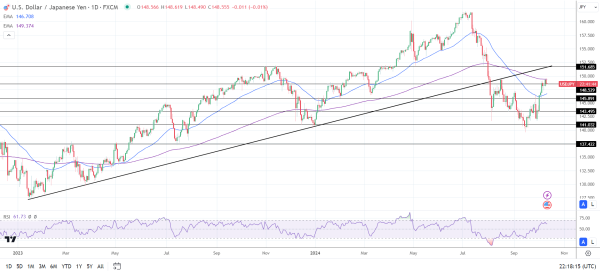Japanese Yen Forecast: Will BoJ Rate Hike Bets Rise on Strong Consumer Sentiment?
Will Consumer Sentiment Shift the USD/JPY Market This Week?
On Friday, October 11, Japan’s Thomson Reuters IPSOS Primary Consumer Sentiment Index could influence demand for the USD/JPY.
The Index is based on a consumer-targeted survey with 11 questions. For the Bank of Japan (BoJ), insights into consumers’ financial situation, labor market sentiment, and comfort in making purchases could be pivotal.
Positive sentiment toward labor market conditions and financial stability could signal rising wage growth and stronger consumer spending.
Upward trends in the Index may indicate a pickup in household spending, possibly fueling demand-driven inflation. Higher consumer prices could refuel bets on a late Q4 2024 Bank of Japan rate hike. A more hawkish BoJ rate path may drive the USD/JPY toward 147.5.
Expert Views on the Bank of Japan Rate Path
Jeffrey P. Snider, Host of Eurodollar University Channel, commented on Japan’s latest leading economic indicator, stating,
“Japan’s leading economic indicator hits rock bottom, proving Bank of Japan’s caution. Not only that Japan M2 credit proxy hits seventeen-year low. This decline is attributed to global weaknesses and US presidential election uncertainty, impacting not only Japan […]. The Bank of Japan has decided not to pursue further rate hikes due to the unstable global economic outlook, recognizing the signs of a potential global recession looming on the horizon.”
US Producer Prices and Consumer Sentiment in Focus
Meanwhile, key US economic indicators will also influence USD/JPY trends. Later in the Friday session, US producer prices and consumer sentiment could impact sentiment toward the Fed rate path.
Economists expect producer prices to increase by 1.6% year-on-year in September, down from 1.7% in August. Economists consider producer prices a leading indicator of consumer prices. As demand weakens, producers may lower their prices, passing the savings on to consumers.
While producer prices are important, consumer sentiment trends could offer insight into consumer spending trends. Economists expect the Michigan Consumer Sentiment Index to rise from 70.1 in September to 70.8 in October. Improving sentiment may signal stronger demand, possibly offsetting the influence of producer prices on Fed policy bets.
Upbeat US data could drive the USD/JPY toward 150. However, weak numbers may signal a drop toward 147.5.
Short-term Forecast for USD/JPY
USD/JPY trends will likely hinge on the US data and central bank commentary. Softer producer prices and a fall in consumer sentiment could retrigger bets on a 50-basis point Fed rate cut. However, central bank commentary will be crucial following this week’s economic data releases.
Traders should stay alert as monetary policy chatter, Japan’s economic data, and the US economic indicators will affect trading USD/JPY strategies. Monitor real-time data, central bank views, and expert commentary to adjust your trading strategies accordingly. Stay ahead of the market with our expert insights.
USD/JPY Technical Analysis
Daily Chart
The USD/JPY hovers well above the 50-day EMA while remaining below the 200-day EMA, sending bullish near-term but bearish longer-term price signals.
A USD/JPY break above the 200-day EMA could support a move toward the trend line and the 151.685 resistance level. Selling pressure could intensify at the resistance level. The trend line is confluent with it.
Consumer sentiment, producer prices, and central bank commentary require close monitoring.
Conversely, a break below the 148.529 support level could signal a fall to 147.5. A drop through 147.5 could give the bears a run at the 50-day EMA.
The 14-day RSI at 61.73 suggests a USD/JPY return to 150 before entering overbought territory.
